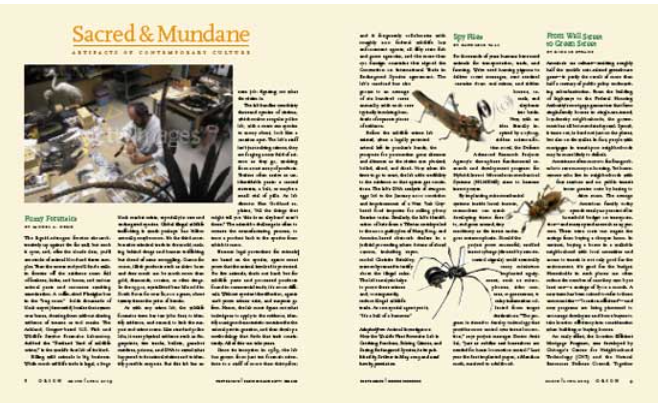Article in Orion Magazine March-April 2009
Click here to see full Orion article as pdf
Sacred & Mundane
Artifacts of Contemporary Culture
Fuzzy Forensics
by Laurel A. Neme
The liquid-nitrogen freezer sits unobtrusively up against the far wall, but crack it open, and, after the clouds clear, you’ll see stacks of animal blood and tissue samples. Turn the corner and you’ll find a walkin freezer off the evidence room full of feathers, hides, and bones, and various animal parts and carcasses awaiting examination. A coffin-sized Plexiglas box in the “bug room” holds thousands of black carpet (dermestid) beetles that swarm over bones, cleaning them without altering evidence of trauma or tool marks. The Ashland, Oregon–based U.S. Fish and Wildlife Service Forensics Laboratory, dubbed the “Scotland Yard of wildlife crime,” is the world’s first lab of its kind.
Killing wild animals is big business. While much wildlife trade is legal, a huge black market exists, especially in rare and endangered species. Global illegal wildlife trafficking is worth perhaps $20 billion annually, maybe more. It’s the third-mostlucrative criminal trade in the world, ranking behind drugs and human trafficking but ahead of arms smuggling. Ounce for ounce, illicit products such as rhino horn and deer musk can be worth more than gold, diamonds, cocaine, or other drugs. In the 1990s, crystallized bear bile sold in South Korea for over $1,000 a gram, about twenty times the price of heroin.
As with any crime lab, the wildlife forensics team has two jobs: first, to identify evidence, and second, to link the suspect and crime scene. Like standard police labs, it uses physical evidence such as fingerprints, tire tracks, bullets, gunshot residues, poisons, and DNA to reveal what happened to its animal victims and to identify possible suspects. But this lab has an extra job: figuring out what the victim is.
The lab handles over thirty thousand species of victims, which makes a regular police lab, with a mere one species to worry about, look like a vacation spot. The lab’s staff isn’t just solving crimes, they are forging a new field of science as they go, working from a vast array of products. Victims often arrive as unidentifiable parts: a carved statuette, a belt, or maybe a small vial of pills. As lab director Ken Goddard explains, “All the things that might tell you ‘this is an elephant’ aren’t there.” The scientific challenge is often to reverse the manufacturing process, to trace a product back to the species from which it came.

